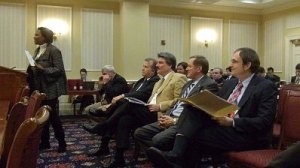>Delegation testifies at mountain naming hearing
>Local representatives against new monikers for Negro, Polish
Elaine Blaisdell
Cumberland Times-News The Cumberland Times-News Wed Feb 23, 2011, 07:59 AM EST
CUMBERLAND — City council members were in agreement at Tuesday’s public work session that population growth, in particular, residents with college degrees, is one of the key components in regard to the economic development of the city.
“I think population growth is critical,” said Mayor Brian Grim.
“I think it’s number one. We need to rebrand the city (with education) from it’s image as a post-industrial town,” said councilman, David Kauffman. “Post-secondary education is the very population that is going to grow the city. The misnomer to this growth is that we are doing it to get jobs. Education in and of itself is an industry, it’s the fifth largest industry in the country.”
Councilman Nick Scarpelli suggested actively working with the already existing education facilities like Allegany College of Maryland and Frostburg State University to expand their programs.
“I still feel we should utilize the talents in the area. We have many people who serve on boards at both the state and federal level that bring something to the table,” said Scarpelli. “We have a willing citizenry and we should use those resources to move forward.”
“I have no desire to undercut the educational institutions already in place. We should ask them if they want to be a part of this initiative,” added Kauffman.
Kauffman suggested seeking help from local officials and the state delegation on the education initiative in order to “prevent Cumberland from being the poorest county in the state.”
“It is going to taken a Herculanian effort on the city’s part to get legislation involved in education,” said resident Larry Jackson.
Councilwoman Mary Beth Pirolozzi said statewide broadband and the reuse of Memorial Hospital are also important for development.
“Statewide broadband is very important. We need it to make a lot of things happen,” said Pirolozzi. “One piece that is a drain is the Memorial Hospital reuse. Filling or selling it needs to be on the top of our radar screen.”
Also discussed during the meeting were they city’s finances.
“Cuts in the highway user revenue have caused us to look at our finances more closely,” said Pirolozzi. “We need to look at the use of our TAN (Tax Anticipation Note), how to eliminate our reliance on it and look at leaner government that is more responsive and less expensive. We need to work at being more accountable and look at the bottom line. We need to establish cash reserve opportunities that go back into a percentage to reduce budget to maintain a constant yield.”
Pirolozzi also suggested reducing finances by looking at personnel in regard to potential retirement and contractual positions and by combining services with the county, especially in regard to taxing and permits and planing.
“We need to make it a one stop shop,” she said.
“I want to make the message clear that we have no desire to cut jobs or people,” added Kauffman.
Grim suggested capping top salaries (setting a range on salaries) in order to alleviate fianancial prolems.
Contact Elaine Blaisdell at eblaisdell@times-news.com

>Western Md. legislators defend mountain names
>
Western Maryland legislators waited for their turn to speak on Tuesday as Sen. Lisa A. Gladden, at left, D-Baltimore City, urged a state Senate committee to pass her resolution to rename Negro and Polish mountains. The Western Maryland lawmakers are, from right: Sen. George C. Edwards, Del. Wendell R. Beitzel, Del. Kevin Kelly and Del. LeRoy E. Myers Jr. (By Andrew Schotz, Staff Writer)
By ANDREW SCHOTZ
andrews@herald-mail.com
9:41 p.m. EST, February 22, 2011
E-mail Print Share Text Size hm-western-md-legislators-defend-mountain-names-20110222
ANNAPOLIS — Western Maryland lawmakers Tuesday defended the names of Negro and Polish mountains, trying to torpedo a Baltimore City state senator’s attempt to “fix” history.
The name battle has been a lively side issue in a legislative session dominated by budget issues and a same-sex marriage debate.
Sen. Lisa A. Gladden, D-Baltimore City, has proposed having a commission suggest new names for Negro Mountain in Garrett County and Polish Mountain in Allegany County.

>Lecture Offered At GC Auditorium On Hydraulic Fracking
>Feb. 17, 2011
An informational program on Marcellus shale natural gas drilling will be offered by Dr. Thomas W. Beauduy on Thursday, Feb. 24, at 7 p.m. in the Garrett College auditorium. Hydraulic fracturing will be addresses, as well as the amount of water required for it and the effect withdrawing the water will have on the available supply.
Beauduy is deputy executive director and counsel to the Susquehanna River Basin Commission (SRBC), a federal-interstate compact commission with water resource management responsibility for the Susquehanna River Basin. As part of his management responsibilities, he oversees government affairs, policy development, and the commission’s regulatory program. In that capacity, he has had a primary role in developing the program for the Marcellus industry.
“Hydraulic fracturing opens the dense shale to release the gas by pumping approximately 4 million gallons of fluid into the well under pressure,” noted a spokesperson. “That fluid is 99.5% water and 0.5% chemicals and sand. The chemicals are used to inhibit bacterial growth, increase the fracture size, and as lubrication along with other applications. The sand is a proppant that keep the fractures open, increasing the amount of gas extracted.”
Part of the lecture will include a presentation about the Maryland Department of the Environment’s water appropriation permitting process and requirements.
For more details on this and future lectures, persons may contact the program assistant, Mikal Zimmerman, at 301-334-6960 or mzimmer8@umd.edu.
University of Maryland Extension programs are open to all citizens without regard to race, color, gender, disability, religion, age, sexual orientation, marital or parental status, or national origin. Those with financial or disability needs that require special assistance for participation in any of the programs should contact the Garrett County Extension Office.
Support the Republican Newspaper! It’s only $9.95/year for the online edition!

>McHenry Resident To Give Presentation On Thru-Hiking The Pacific Crest Trail
>
Feb. 17, 2011
by Mike Logsdon
McHenry resident Charlie Mead will be the featured speaker at the Garrett College Adventuresports Institute Colloquium on Tuesday, Feb. 22, beginning at 7 p.m. in Room 224 of the Continuing Education building on the campus of Garrett College.
His presentation will focus on pre-trip planning, gear selection, and the challenges of long-distance
“thru-hiking” of the Pacific Crest Trail (PCT). A reception for the speaker will begin at 6:30 p.m. in the same room. The reception and presentation are free and open to the public.
Thru-hiking by definition is the process of hiking a long-distance trail from end to end in one continuous effort. For Mead, this latest accomplishment of thru-hiking the PCT took him 172 days. That’s around 15.4 miles per day, on average. For an individual like Charlie, who stands just about six feet tall, that distance represents roughly 32,500 steps per day.
“Although my average PCT day hike was 15.4 miles, my longest was 32 miles,” noted Mead.
Passionate about backpacking and hiking, when asked how he became interested in hiking the trail, Mead indicated, “Twelve years ago, when I thru-hiked the Appalachian Trail, someone I met made me aware of the Pacific Crest Trail and how challenging and beautiful it was. I put it in the back of my mind that, one day, I would hike that trail too.”
The Appalachian Trail (AT) at 2,175 miles and the Pacific Crest Trail (PCT) at 2650 miles represent two of the United States’ three longest north/south hiking trails. Only the Continental Divide Trail is longer at 3,100 miles. All are part of the National Scenic Trails system, a set of 17 individual continuous hiking trails that total a distance of just over 17,000 miles.
Support the Republican Newspaper! It’s only $9.95/year for the online edition!

>Census: Near-record level of US counties dying
>By HOPE YEN and JOHN RABY, Associated Press Hope Yen And John Raby, Associated Press – 11 mins ago
WELCH, W.Va. – Nestled within America’s once-thriving coal country, 87-year-old Ed Shepard laments a prosperous era gone by, when shoppers lined the streets and government lent a helping hand. Now, here as in one-fourth of all U.S. counties, West Virginia’s graying residents are slowly dying off.
Hit by an aging population and a poor economy, a near-record number of U.S. counties are experiencing more deaths than births in their communities, a phenomenon demographers call “natural decrease.”
Years in the making, the problem is spreading amid a prolonged job slump and a push by Republicans in Congress to downsize government and federal spending.
“You’re the anchors of our Main Streets,” President Barack Obama told small business leaders in Cleveland on Tuesday. “We want your stories — your successes, your failures, what barriers you’re seeing out there to expand. .How can America help you succeed so that you can help America succeed?”

>U.S. maple sugaring season gets running early
>msnbc.com news services
updated 2/18/2011 10:22:37 PM ET 2011-02-19T03:22:37
ASHFIELD, Mass. — The sugar maple trees are tapped and their rich sap is starting to drain into buckets across New England and elsewhere, as a midwinter thaw heralds the start of the fleeting syrup production season.
But challenges loom for harvesters, racing against time and the elements to gather enough sap to boil into the sweet delicacy, first cultivated centuries ago by Native American communities.
Despite the thaw, snow piles of three feet in the northern woods and high snowbanks along back roads after the stormy January have complicated the start of sugaring season…
Maryland: About 30 syrup makers are clustered around the mountains and valleys of Deep Creek lake in the western part of the state, The Washington Post reported. Steyer Brothers Farm, the oldest and largest producer in western Maryland, makes about 1,000 gallons of syrup in a good year. The farm has 8,500 taps for maple sap on 100 acres and uses 35 miles of tubing in the process of making maple syrup, the Cumberland Times-News says.

>Local man cherishes history behind mountains’ names
>
Matthew Bieniek
Cumberland Times-News The Cumberland Times-News Fri Feb 18, 2011, 08:00 AM EST
— CUMBERLAND — For Leonard “Harold” Biggs, Western Maryland’s mountains are part of history, and part of his family’s history. And to Biggs, a proposed change to the names of local mountains is like trying to go back in time and change the reality of the past.
“They’re messing with history, heritage and a way of life,” said Biggs. “What do we have to do, destroy the past?”
Biggs was referring to Senate Joint Resolution 3, which seeks to have a committee appointed to rename Negro and Polish mountains. The resolution would have the governor establish and appoint the members of the naming commission, who would be required to decide on new names by Dec. 31. Negro Mountain in Garrett County reaches a height of 3,075 feet and Polish Mountain in Allegany County climbs 1,783 feet from sea level.
One of Biggs’ prized possessions is a limited-edition painting by Lee Teter, a well-known artist who grew up in Allegany County. Teter is also kin to Biggs. The painting is called “Death of Nemesis, Birth of Negro Mountain.” The painting depicts a dying black man being comforted by Col. Thomas Cresap. Biggs has loaned the painting out, including to the Westernport Library, where it has been well-received by people of all backgrounds. Teter produced a historical article for purchasers of the painting, which begins: “In the Appalachian Mountains there is a monument to a black frontiersman.”
And understanding the history behind the naming of the mountains would quash the idea the names of the mountains are racist, or politically incorrect, Biggs said. Almost every mountain and stream name in Western Maryland is related to the American Indians. Should those names all be changed, Biggs asked.
Biggs was born in Luke, and lived on Georges Creek, but then moved away for 45 years. He spent 17 years serving his country in the Army and the Coast Guard. He moved back home in 2000. His family settled on the Cheat River in 1773. A land grant signed by Thomas Jefferson gave land to William Biggs. The land grant required Biggs to build a cabin, clear land and plant a certain amount of corn. Family history passed down through generations said that Biggs’ ancestors also served with Cresap.
“The people of the city of Baltimore need to clear their own doorstep. They have plenty of problems there,” said Biggs, referring to the fact that several of the senators sponsoring the resolution are from Baltimore.
The history behind the naming of both Polish Mountain and Negro Mountain has been disputed, but recent findings have clarified some uncertainties. Local historian Champ Zumbrun has located a 1797 deed in the Maryland State Archives which clearly reads “Polished Mountain.”
“We still don’t know how it got that name, but it’s pretty clear the mountain didn’t initially refer to a nationality,” he said.
The history of the naming of Negro Mountain presented by Teter and most others is largely in agreement. A black man accompanying Cresap’s rangers during the French and Indian War saved Cresap’s life, and lost his own, in a battle with Indians. He was probably a free black man, and his name was Nemesis, although some accounts say he was named Goliath. He was a man of large stature. Nemesis is supposed to have had a premonition of his own death, which he disclosed to Cresap before the battle. After Nemesis was laid to rest on the mountain, the mountain was named in his honor.
“They were honoring the man that was killed, that’s the thing. It wasn’t meant to be derogatory. It was all they knew,” Biggs said.
Bernard Wynder, the new president of the Allegany Chapter of the NAACP, has a different take on the matter than Biggs does.
“My basic feeling is that if we know the name of the individual, name it after the individual. That would be fair and just,” said Wynder. Wynder said he was offering a personal opinion and not speaking for the NAACP. “Why are we continuing to have these debates?”
There’s one thing both Wynder and Biggs agree on, though, and that’s the name Negro Mountain should have if it’s changed. The name should be Nemesis. Wynder is in favor of renaming the mountain, period. Biggs would be reluctant to change the mountain’s name, but if the mountain must be renamed, he’d be least bothered by changing the name to Nemesis.
To see the Polished Mountain deed, visit: http://plato.mdarchives.state.md.us/msa/stagser/s1500/s1529/cfm/dsp_unit.cfm?county=al&qualifier=S&series=1188&unit=2164
For more on Negro Mountain, visit: http://www.whilbr.org/itemdetail.aspx?idEntry=3024&dtPointer=2
Contact Matthew Bieniek at mbieniek@times-news.com

>Controversy over 'Negro Mountain' reveals urban-rural divide
>18th century tribute fuels 21st century debate
Grantsville, MD 21536, USA
By Julie Bykowicz, The Baltimore Sun
8:55 p.m. EST, February 20, 2011
GRANTSVILLE — — Bryant Bunch, who came from Prince George’s County to attend college here at the far end of the Maryland panhandle, first saw the sign on Interstate 68 while traveling with a carload of friends a few years back.
He remembers their reaction: Does that say what we think it says?
Maxine Broadwater, born and raised on a farm outside Grantsville, and the town’s librarian for three decades, recalls the first time she ever gave the name a second thought. It was the early 1990s, and people passing through had stopped at her library to ask about it.
Her thought: Why would that bother anybody?
Those disparate reactions to “Negro Mountain,” the name that 18th-century settlers gave to the Garrett County landmark, have found their echo in Annapolis, where a Senate panel will begin debate this week on whether it should be changed.

>Federal Budget Proposals Fail To Impress Maryland Delegation
>
Support the Republican Newspaper! It’s only $9.95/year for the online edition!
Feb. 17, 2011
by Andy Marso
Capital News Service
WASHINGTON – With the ink barely dry on various 2012 federal budget proposals, the Maryland congressional delegation began working on shaping the final product this week.
Rep. Steny Hoyer, D-Mechanicsville, weighed in on the Republicans’ plan to trim spending; Sen. Ben Cardin, D-Baltimore, called President Obama’s budget proposal “a credible first step,” in need of adjustment; and Rep. Donna Edwards, D-Fort Washington, and Rep. Roscoe Bartlett, R-Frederick, teamed up to push for tax relief for research and manufacturing.
On the House floor Wednesday, Hoyer opposed the Republican-authored continuing resolution bill introduced in the House Appropriations Committee Friday that takes President Obama’s 2011 request and cuts another $100 billion.
“I agree that reducing spending is part of the fiscal solution,” Hoyer said. “But let’s reduce spending wisely, instead of doing it in such a way that costs America jobs. When we talk about cutting investments in education, in innovation, and in infrastructure, we are talking about cutting tomorrow’s jobs.”
Republicans swept into power in the House last November in part by promising to rein in a budget deficit that hit an estimated $1.65 trillion last year. Their budget proposal would cut funding to a host of federal agencies including the Food and Drug Administration, Homeland Security, Transportation, and Housing and Urban Development.

>U. of Md. Extension study values state's natural gas reserves at $5.9 billion to $49 billion
>CUMBERLAND, Md. (AP) – A study of natural reserves in western Maryland puts the prospective lifetime value at $5.9 billion to $49.1 billion.
University of Maryland Extension workers who crunched the numbers said Friday that Garrett County has about twice the production potential of neighboring Allegany County.
The study was done to educate public officials and private citizens about untapped reserves of natural gas in the Marcellus Shale, a mineral-rich geological formation that extends from New York to Virginia.












